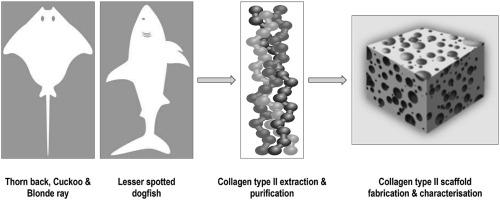Journal of Science: Advanced Materials and Devices ( IF 6.7 ) Pub Date : 2021-05-07 , DOI: 10.1016/j.jsamd.2021.04.002 Z. Wu , S.H. Korntner , A.M. Mullen , D.I. Zeugolis

|
The limited capability of articular cartilage to self-repair renders its regeneration a formidable challenge. In the quest of the optimal material for cartilage scaffold fabrication, the use of collagen type II has been advocated, but its optimal source still remains elusive. Herein, the potential of four [lesser spotted dogfish (Scyliorhinus canicula), thorn back ray (Raja clavata), cuckoo ray (Leucoraja naevus) and blonde ray (Raja brachyuran)] cartilaginous fish (chondrichthyes) derived collagen type II preparation in cartilage engineering was assessed. Collagen type II was extracted using the acid-pepsin method, crosslinked with 4-arm poly (ethylene glycol) succinimidyl glutarate sponges were fabricated and their biophysical, biochemical and biological properties were assessed. Pure collagen type II preparations were obtained from all four chondrichthyes, as revealed by gel electrophoresis. Pore size, porosity, mechanical properties, denaturation temperature, free amine content and resistance to enzymatic degradation of the produced sponges were not significantly (p > 0.05) affected as a function of species. Biological analysis using human adipose derived stem cells revealed no significant (p > 0.05) differences between the groups in cell viability, DNA concentration, metabolic activity, Alcian blue staining and sulphated glycosaminoglycans synthesis. Human adipose derived stem cells seeded on fish-derived scaffolds expressed lower mRNA levels of COL1A1 (fold change ≥ 2.0) and COL3A1 (apart from lesser spotted dogfish; fold change < 2.0) and higher mRNA levels of COL10A1 (fold change ≥ 2.0), COMP (fold change ≥ 2.0), SOX9 (fold change ≥ 2.0), and ACAN (apart from cuckoo ray; fold change < 2.0) than cells grown on tissue culture plastic. Our data suggest that chondrichthyes derived collagen type II has the potential to be used in cartilage engineering.
中文翻译:

寻找用于关节软骨胶原海绵开发的最佳软骨鱼类
关节软骨自我修复能力有限,使其再生成为一项艰巨的挑战。在寻求制造软骨支架的最佳材料的过程中,一直提倡使用 II 型胶原蛋白,但其最佳来源仍然难以捉摸。在此,四种[小斑角鲨(Scyliorhinus canicula)、刺背鳐(Raja clavata)、杜鹃鳐(Leucoraja naevus)和金发鳐(Raja brachyuran)的潜力)] 软骨鱼 (chondrichthyes) 衍生的 II 型胶原蛋白制备在软骨工程中进行了评估。使用酸-胃蛋白酶法提取 II 型胶原蛋白,制备与 4 臂聚(乙二醇)琥珀酰亚胺戊二酸海绵交联并评估其生物物理、生物化学和生物学特性。正如凝胶电泳所揭示的那样,从所有四种软骨鱼中都获得了纯 II 型胶原蛋白制剂。孔径、孔隙率、机械性能、变性温度、游离胺含量和生产的海绵对酶促降解的抵抗力 作为物种的函数没有受到显着影响(p > 0.05)。使用人脂肪来源的干细胞进行的生物学分析显示没有显着性 ( p > 0.05) 各组之间在细胞活力、DNA 浓度、代谢活性、阿尔辛蓝染色和硫酸化糖胺聚糖合成方面的差异。接种在鱼源性支架上的人脂肪源性干细胞表达较低的 COL1A1(倍数变化 ≥ 2.0)和 COL3A1 mRNA 水平(除了较小的斑点角鲨;倍数变化 < 2.0)和更高的 COL10A1 mRNA 水平(倍数变化 ≥ 2.0), COMP(倍数变化 ≥ 2.0)、SOX9(倍数变化 ≥ 2.0)和 ACAN(布谷鸟射线除外;倍数变化 < 2.0)与在组织培养塑料上生长的细胞相比。我们的数据表明软骨鱼类衍生的 II 型胶原蛋白具有用于软骨工程的潜力。











































 京公网安备 11010802027423号
京公网安备 11010802027423号